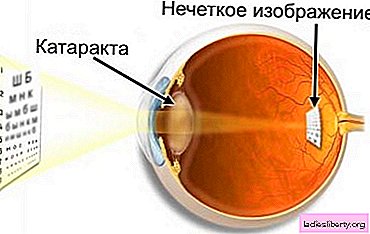
Cataract called an eye disease, which consists in clouding of the main substance or lens capsule (reducing their transparency), accompanied by a decrease in visual acuity. Cataracts can be congenital and acquired; progressive or stationary.
Congenital cataract does not progress, and if the clouding is not significant and does not pose a danger to the normal development of the child’s visual system, then specialist supervision is indicated without any drastic therapeutic measures.
Acquired cataract may be:
- traumatic;
- complicated (that is, resulting from a complication of any eye or general disease);
- age (developed during the aging process of the body).
Cataracts - Causes
There are no exact data on the reasons for the development of cataracts today, as well as an explanation of why one eye is often more injured than the other. The only known fact is that cataract is formed due to the accumulation of lens cells that died as a result of slagging of the blood, which leads to clouding.
The main risk factor for cataracts is age. The first initial clouding in the lens usually begins to appear at the age of 40 to 50 years. Approximately half of people who have reached the age of 65 have, to one degree or another, a clouding of the lens, sometimes without visual impairment.
Cataracts can also develop with diabetes mellitus, cataracts in family members, trauma or inflammatory eye diseases in the past, eye operations, prolonged use of glucocorticosteroids, prolonged exposure to the sun, prolonged exposure to ionizing radiation, and smoking.
Cataract Symptoms
Symptoms of cataracts are determined by the degree of damage to the lens. As a rule, the disease manifests itself:
- double vision in the sore eye with the second eye closed;
- vagueness, nebula of the image, which cannot be corrected with glasses;
- the appearance of myopia;
- a feeling of glare, flashes, especially at night;
- photophobia;
- the appearance of halos around light sources;
- deterioration in color vision.
Cataract Diagnosis
In order to diagnose cataracts, a special examination is performed. First of all, it includes checking visual acuity, then a study using a slit lamp (a special microscope that allows you to see the structures of the front of the eye at high magnification). The retina is also examined using a slit lamp or an ophthalmoscope.
Cataract - treatment and prevention
As a rule, cataracts are treated by surgical removal. In this case, a clouded lens is replaced with an artificial one. The most advanced cataract surgery is ultrasound phacoemulsification. Today, this operation is considered quite common throughout the world; it is performed on an outpatient basis under local anesthesia.
In 95% of cases, it helps to improve the vision of patients. During such an operation, the surgeon replaces the lens affected by cataract, artificial, plastic or silicone. Previously, the lens was removed along with the capsule, but today the lens capsule is left in place by placing a new lens in it.
For the treatment of cataracts, early diagnosis is very important. All persons under 65 years of age should be examined every 2-4 years by an ophthalmologist; reaching 65 years of age, such a survey is recommended every 2 years.
In order to slow down the development of cataracts in old age, you should use eye drops vytinin, vitafacol, etc.
For the prevention of cataracts, doctors recommend stopping smoking and follow a balanced diet.











